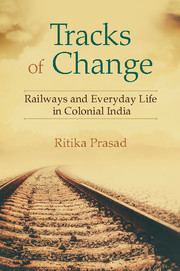Book contents
- Frontmatter
- Dedication
- Contents
- List of Tables and Figures
- Acknowledgements
- List of Abbreviations
- Introduction
- 1 The Nature of the Beast? An Elementary Logic for Third-Class Travel
- 2 Demand and Supply? Railway Space and Social Taxonomy
- 3 Crime and Punishment: In the Shadow of Railway Embankments
- 4 Railway Time: Speed, Synchronization, and ‘Time-Sense’
- 5 Contagion and Control: Managing Disease, Epidemics, and Mobility
- 6 Designing Rule: Power, Efficiency, and Anxiety
- 7 Marking Citizen from Denizen: Dissent, ‘Rogues,’ and Rupture
- Conclusion
- Bibliography
- Index
- About the Author
7 - Marking Citizen from Denizen: Dissent, ‘Rogues,’ and Rupture
Published online by Cambridge University Press: 05 September 2015
- Frontmatter
- Dedication
- Contents
- List of Tables and Figures
- Acknowledgements
- List of Abbreviations
- Introduction
- 1 The Nature of the Beast? An Elementary Logic for Third-Class Travel
- 2 Demand and Supply? Railway Space and Social Taxonomy
- 3 Crime and Punishment: In the Shadow of Railway Embankments
- 4 Railway Time: Speed, Synchronization, and ‘Time-Sense’
- 5 Contagion and Control: Managing Disease, Epidemics, and Mobility
- 6 Designing Rule: Power, Efficiency, and Anxiety
- 7 Marking Citizen from Denizen: Dissent, ‘Rogues,’ and Rupture
- Conclusion
- Bibliography
- Index
- About the Author
Summary
Some years before he would begin amassing hundreds of miles of rail travel across India, M. K. Gandhi postulated that railways, along with lawyers and doctors, were ruining the country. This statement became staple fodder for those who saw in Gandhi's condemnation of railways the heart of his apparently obscurantist views about technology. Others deemed it a sign of bad faith, seeing that Gandhi's extensive journeying across India on railway trains was integral to how he discovered the country, and the country discovered him: it was not only the image of Gandhi striding stick in hand that became a staple of nationalist iconography but also that of him at the door of a railway carriage, the station platform crowded with people demanding ‘darshan.’ However, even as darshan ‘occupies a prominent place in descriptions of Gandhi's tours,’ Shahid Amin has demonstrated how popular appropriation of Gandhi in Gorakhpur in 1921–22 not only varied from the formats prescribed by the local Congress-Khilafat leadership but also ‘clashed with the basic tenets of Gandhism itself.’
This disjunction offers an important lens to examine the ways in which railways became central to the language and practice of dissent in colonial India. At the level of discursive nationalism, railways were central to conversations about what precisely constituted India's ruin (or progress); in more corporeal ways, they were vital to how nationalist elites physically transported themselves and the dictates of satygraha into India's interiors. Thus, railway lines, which had been imagined as conduits that allowed India's rulers to travel to hill stations to recuperate and replicate a sense of home, instead became the means through which the message of satyagraha was transmitted. Similarly, railway stations, which were seen to be armoured and defensible spaces where imperial populations could seek refuge if threatened, became vital spaces for anti-imperial mass agitations.
However, even as the crowded train doorway, the politically tense platform, or burnt signal room embodied the nation reclaiming railways from imperial control, these spaces also marked disjunctions between elite and popular politics.
- Type
- Chapter
- Information
- Tracks of ChangeRailways and Everyday Life in Colonial India, pp. 234 - 262Publisher: Cambridge University PressPrint publication year: 2015



